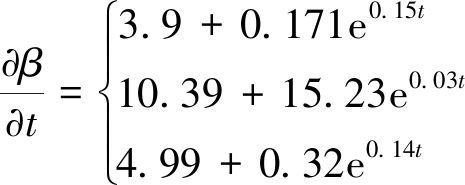煤自燃是影响矿井安全生产的主要危害之一,不仅造成大量煤炭资源浪费,而且会产生大量温室气体(CO2和CH4)[1-4]、有毒有害气体(CO,SO2,H2S,N2O,NOx等)以及一些重金属微量元素(As,Se,Hg等)[5]。因此,煤火灾害防治是人员身体健康、安全生产的重要保证。火源探测技术作为防灭火工程的重要技术之一,在火灾治理过程中占据重要地位。目前,火源探测技术主要有:温度法[6]、磁探法[7]、电阻率法、气体测量法[8]、同位素测氡法[9]、无线电波法、地质雷达探测法[10]、遥感法[11]以及计算机数值模拟法[12]。
火源精准探测一直是防灭火工程的世界性难题。测氡法作为现阶段火源精准探测的主要方法之一,在实践过程中取得了较好效果。从20世纪80年代开始,放射性物探技术被应用于火源探测。太原理工大学防灭火课题组提出了“煤层自燃火源位置精准探测技术”,并自行研制了国内外最大的煤自燃及测氡(222Rn)实验台[13]。基于此实验台,薛生等[14]研究了氡析出与煤温的关系;王俊峰[13]研究了地下煤层自燃时上覆岩层中氡气运移规律;刘艳[15]研究了煤氧化升温过程中氡析出与自然发火指标气体的关系。此外,该技术已在多个矿井中实施,取得了较好的效果。然而,上述研究均以“geogas”运移理论[16-19]为背景,建立并完善了同位素测氡技术的理论基础。但现有测氡方法实际探测深度为500 m,随着我国矿井采深不断增加(>700 m)[20],地质构造愈来愈复杂,地表测氡技术已无法满足生产需求。此外,对于采空区浮煤自燃,受采动及复杂地质构造影响,采空区上部均可能产生氡异常现象,所以,地表测氡技术难以精准定位采空区火源位置,针对性采取措施,防治煤自燃。
基于此,笔者以松散煤堆为研究对象,结合均匀多孔介质氡析出、运移理论,基于自然发火实验台,探索松散煤堆发火过程氡析出、运移规律,以期对采空区火源精准探测提供依据。
1 实 验
1.1 实验原理
1.1.1 煤自然发火原理
煤自然发火是由于煤与氧接触时发生化学吸附和化学反应放出热量,当放出热量大于散发的热量时,煤温上升而导致自然发火[21-22]。煤低温自然发火实验就是该过程的模拟,即在实验条件下,依靠煤自身氧化放热升温,考察煤温、O2消耗量、CO产生量以及其他气体的变化规律。
1.1.2 实验分析过程原理
为明确本实验目的,对分析过程进行简单描述,如图1所示。

图1 分析过程原理
Fig.1 Schematic diagram of the analysis process
1.2 实验装置
自然发火实验主要基于西安科技大学XK-VII型煤自然发火实验装置[23-24]。实验装置连接设计为局部气体循环体系,如图2所示,主要由自然发火实验台、供气装置、干燥瓶、干燥管、RAD17连续性测氡仪、流量计、单向流量调节阀组成,各部分均通过外径6 mm的PC管串接在一起,且每个连接端口通过玻璃胶密封。为保证进入测氡仪的气体水分小于10%,实验台出气口连接干燥瓶、干燥管,主要目的有:一是过滤和吸收气体中的水分和杂质;二是冷凝作用,降低气体温度。其中,干燥瓶连接时采用长进短出的形式。RAD17测氡仪内置空气泵,在不影响发火实验的情况下,通过流量调节阀、流量计来调节气流量,将气体排出量控制在250 mL/min。

图2 自然发火实验
Fig.2 Spontaneous combustion experiment
1.3 煤样制备及基本条件
(1)煤样制备
按实验标准获取、制备煤样,在煤体破碎过程中,从破碎煤体里取出部分混合煤样(1 550 g)进行粒径筛选分析,获得实验煤样的粒度分布范围见表1。实验台总的装煤量为1 606.1 kg,自然发火实验基本参数见表2。
表1 煤粒度分析结果
Table 1 Coal particle size analysis results

粒度/mm+10-10,+7-7,+5-5,+3-3,+0.9-0.9质量/g298.00182.00204.00318.50228.00319.50频度/%0.1920.1170.1320.2050.1470.206
注:“+”表示未过筛,“-”表示过筛。
表2 煤样实验条件
Table 2 Experimental conditions for coal samples

煤样平均粒径d50/mm装煤高度/cm煤质量/kg煤样体积/cm3块煤密度/(g·cm-3)密度/(g·cm-3)空隙率η供风量/(m3·h-1)起始温度/℃CJG4.911751 606.11 865 1601.40.860.384 90.1~0.733.4
(2)炉体内换气时间
假设整个炉体内碎煤分布均匀,根据上述实验条件,获得不同供风条件下破碎煤体内风流运移速率。炉体内装煤高度为1.75 m,所以在理想条件下,完成一次气体交换预估时间可通过式(1)计算,其结果见表3。
t=HA/Q
(1)
式中,H为炉膛内煤体高度,m;A为炉体内煤样空隙的断面面积(A=A0η,A0为实验台横截面积),m2;Q为供风量,m3/h;t为炉体内完成一次换气所需时间,s。
表3 不同供风量下煤体内空气运移速度
Table 3 Air transport velocity in coal samples under different air supply volumes

序号供风量Q/(m3·h-1)运移速度v/(m·s-1)炉体内完成一次换气所需时间t/s10.16.38×10-527 42920.21.27×10-413 78030.31.91×10-49 16340.42.55×10-46 86350.53.19×10-45 48660.74.47×10-43 915
1.4 实验过程
在自然发火实验中,煤样温度从常温升至170 ℃持续了45 d。在此期间,为满足高温点位置处氧浓度需求,供风量从0.1 m3/h逐级变化到0.7 m3/h,其高温点温度随时间变化的关系可通过图3来表示。测氡仪连续运行2个周期,每次取气时间设置为5 min,总取气量为2 500 mL。松散煤体内高温点温度值每升高(5±0.5)℃,需经过24~36 h达到平衡,之后进行循环测量。

图3 高温点温度随时间变化
Fig.3 Temperature of the high temperature point varies with time
2 煤自然发火过程氡分布规律
2.1 氡活度浓度分布理论
氡在均匀多孔介质中传播[25]的一般方程:
![]()
 v-v
v-v C-ληC+a
C-ληC+a
(2)
式中,C为介质中氡的孔隙活度浓度,Bq/m3;η为介质的孔隙度;D为氡在介质中的扩散系数,m2/s;v为介质中流体的渗流速度;λ为氡的衰变常数,1/s;a为介质产生可运移氡的能力,Bq/(s·m3)。
对于发火实验台,风量稳定时,其内部氡活度浓度分布总处于一个动态平衡中,将式(2)进行简化,据此,可建立孔隙介质中氡稳态运移的一维微分方程:
![]()
(3)
式中,C(x)松散煤堆中心高度x位置处的孔隙氡活度浓度,Bq/m3。
当破碎煤体内氡运移完全由渗流所主导时,可忽略氡的扩散运移作用,式(3)可简化为
![]()
(4)
初始条件x=0时,C(0)=C0,则通过式(4)可获得破碎煤堆内一维氡活度浓度分布函数为
![]()
(5)
2.2 同一时间沿轴线氡活度浓度分布
对实验数据进行整理,绘制图4。当供风量Q=0.1 m3/h、煤体最高温度Tmax<50 ℃时,氡活度浓度沿轴线方向呈线性递增;当供风量Q=0.1 m3/h、50<Tmax<70 ℃时,氡活度浓度沿轴线方向先线性增长,后出现波动式减小,其突变点位于125~165 cm。产生上述结果原因可能为:自然发火前期,煤体氧化升温速率较慢,热量释放和氡析出量比较少,此时,沿轴线方向氡运移以渗流为主;当煤温达到临界温度时,氧化速率加快,热量释放增多,高温点附近耗氧量增加。当与进风口距离L大于125 cm时氧浓度大幅度降低,气体流量不足以维持渗流状态,此时,仅在一定范围内,氡运移以渗流为主。当供风量Q=0.2~0.7 m3/h,Tmax>70 ℃时,氡活度浓度沿轴线方向均先增大后减小,其突变点范围分别为125~145,105~125,105 cm。此外,实验中发现,供风量Q=0.2 m3/h、Tmax>70 ℃时,距离进风口145 cm位置高温气体遇冷液化产生大量水。综上,随着松散煤体温度的升高,氧化升温速率加快,高温点位置向下移动,耗氧量增加;当L小于105~125 cm时,氡活度浓度沿轴线方向基本呈线性关系,在此高度范围内认为氡运移以渗流为主;由于实验装煤总高175 cm,由此可知多种运移方式耦合作用范围为50 cm,该值与同位素测氡法埋杯深度基本一致。
2.3 同一位置不同温度氡活度浓度分布
由图5可知,当L=25 cm时,氡活度浓度随煤温变化先增长后趋于平稳;当25 <L≤185 cm时,氡活度浓度随煤温呈指数增长,在L=65,105,125 cm位置处,氡值随煤温变化增长趋势基本一致,且在此温度范围内,变化规律与文献[26]获得规律一致,可作为煤自燃发火程度判断依据。

图4 沿轴线方向氡活度浓度变化
Fig.4 Variation of radon activity concentration along axis

图5 不同位置氡活度浓度随温度变化规律
Fig.5 Variation of radon activity concentration with temperature at different locations
3 煤自然发火过程氡运移规律
由于煤体导热性差,沿轴线方向温度差异越来越大。实验开始时,L=5 cm位置处始测温度为40 ℃;当煤体内Tmax=170 ℃时,L=185 cm位置轴心温度仅为70 ℃,L=165 cm和L=145 cm轴心温度为85 ℃,L=125 cm处轴心温度接近90 ℃。所以,为了解同一温度条件下沿轴线氡活度浓度的分布规律,将煤温为40,50,60,70,85,90 ℃时轴线各位置对应氡活度浓度值按风速等效换算后绘制图6。
从图6可以看出,当煤温处于40~70 ℃时,从整体来看,氡活度浓度沿轴线方向呈指数增长。当煤温T=85 ℃时,在L<125 cm范围内,氡活度浓度沿轴线方向先增加后趋于平稳;而在L≥125 cm范围,氡活度浓度又呈递增趋势。煤温T=90 ℃时,在L≤125 cm范围,氡活度浓度沿轴线方向先增加后趋于平稳。由上文可知,炉体内装煤高度为175 cm,多种运移方式耦合作用范围为50 cm,所以对L<125 cm的氡活度浓度进行局部拟合,获得图7。

图6 同一温度不同高度氡活度浓度
Fig.6 Radon concentration at the same temperature in different positions

图7 与进风口距离L≤125 cm氡活度浓度分布
Fig.7 Distribution of radon activity concentration less than 125 cm from the inlet
由图7可知,当煤温处于40~90 ℃时,从整体看,氡活度浓度沿轴线方向均先增加,达到65 cm位置时,氡值趋于稳定,拟合曲线与式(5)相吻合,满足y=y0+AeR0x,参数见表4。从理论上进一步证明在L≤125 cm,沿轴线方向氡运移以渗流为主。基于氡运移规律,可为松散煤堆发火位置判断提供依据。
4 松散煤堆自然发火过程氡析出规律
对每一层高进行划分,以L=125 cm为例,假设该位置上下10 cm为一均匀多孔介质单元。按此假设对每个高度依次划分,如图8所示,其中每个单元体积V、截面面积S均相同。每个单元相邻两点间温度差值相对较小,因此,同一个单元内可忽略温度差异对氡值的影响。同一个均匀多孔介质单元,其内部氡主要由以下几部分组成,分别为破碎煤体产生的可自由移动的氡、衰变减少的氡、外界流入单元的氡以及流出单元的氡。
表4 沿轴线方向氡活度浓度分布函数参数
Table 4 Parameters of the distribution function of radon activity concentration along the axis direction

参数煤温/℃405060708590y070.8125.5166.3225.9837.41 651.6A-58.9-109.7-142.4-175.4-849.4-1 781.7R0-0.03-0.06-0.06-0.04-0.03-0.03
为获得低温氧化阶段氡析出规律,对各单元氡活度浓度分布进行分析,建立氡体积分数平衡关系式,表达式为
![]()
(6)
式中,βi为不同温度下单位体积氡析出量(主要包括富集氡和衰变产生氡),Bq/m3;V为单元体积,m3;S为单元截面面积,m2;δi为单元上表面氡析出率,Bq/(s·m3);δi-1为单元下表面氡流入率,Bq/(s·m3)。
令Rin表示单元内流入氡的量,Rout表示单元内流出氡的量,那么
Rin=∮Sδi-1dS
(7)
Rout=∮SδidS
(8)
所以,式(6)可简化为
![]()
(9)
由上述氡平衡关系可知,沿轴线方向,当且仅当Rin=Rout,此时该位置才能反映出氡析出与煤温的真实关系。由图7可知氡值稳定范围为65~125 cm,此时,在该区间内有Rin=Rout,所以在65≤L≤125 cm能够真实反映氡析出规律。

图8 均匀多孔介质单元氡活度浓度变化
Fig.8 Changes of radon activity concentration in a uniform porous medium unit
此时,当65≤L≤125 cm时,关系式可简化为
![]()
(10)
去掉积分号,等式仍然成立,简化为
![]()
(11)
65,105,125 cm位置煤温与发火时间关系,如图9所示。由图9可知,煤温随发火时间呈线性增长,且增长趋势一致。因此,近似认为在65≤L≤125 cm内,沿轴线方向氡活度浓度分布较为均匀。由图5,9可获得不同位置氡活度浓度与煤温、煤温与发火时间的拟合关系式:
![]()
(12)
![]()
(13)
![]()
(14)
将式(8),(9),(10)代入式(7),可得到65,105,125 cm处氡析出与发火时间的关系:

(15)
值得注意的是,式(5)中发火时间t对应的温度区间为40~90 ℃。

图9 煤温与发火时间关系
Fig.9 Relationship between coal temperature and ignition time
5 结 论
(1)当高温点煤温小于50 ℃时,煤氧复合反应缓慢,耗氧量低,氡活度浓度沿轴线方向呈线性分布,氡运移以渗流为主;当高温点煤温大于50 ℃时,此时升温速率加快,耗氧量增加,高温点位置发生变化,渗流影响范围逐渐减小;当高温点煤温大于70 ℃时,多种运移方式耦合作用范围为50 cm,与同位素测氡法埋杯深度基本一致。
(2)同一温度条件下,当L≤125 cm,氡活度浓度沿轴线先增长后趋于平稳,其中,平稳段对应范围为65≤L≤125 cm;在此范围内,氡活度浓度随煤温升高呈指数增长,且存在特征温度点,可作为煤自燃发火程度判断的依据。
(3)通过氡析出与煤温、煤温与发火时间的关系,推导了氡析出与发火时间的关系式;通过对松散煤堆内氡析出、运移规律分析,可为采空区火源判断提供依据。
[1] ONIFADE M,GENC B.Comparative analysis of coal and coal-shale intrinsic factors affecting spontaneous combustion[J].International Journal of Coal Science & Technology,2018,5(3):282-294.
[2] KUENZER C,STRACHER G B.Geomorphology of coal seam fires[J].Geomorphology,2012,138(1):209-222.
[3] DIJK P V,ZHANG J,WANG J,et al.Assessment of the contribution of in-situ combustion of coal to greenhouse gas emission;based on a comparison of Chinese mining information to previous remote sensing estimates[J].International Journal of Coal Geology,2011,86(1):108-119.
[4] WU J J,LI X C.Risk assessment of underground coal fire development at regional scale[J].International Journal of Coal Geology,2011,86(1):87-94.
[5] ZHAO Y,ZHANG J,CHOU C L,et al.Trace element emissions from spontaneous combustion of gob piles in coal mines,Shanxi,China[J].International Journal of Coal Geology,2008,73(1):52-62.
[6] ZHANG J Z,KUENZER C.Thermal surface characteristics of coal fires 1:Results of in-situ measurements[J].Journal of Applied Geophysics,2007,63(3):117-134.
[7] SHAO Z,WANG D,WANG Y,et al.Theory and application of magnetic and self-potential methods in the detection of the Heshituoluogai coal fire,China[J].Journal of Applied Geophysics,2014,104(1):64-74.
[8] LU P,LIAO G X,SUN J H,et al.Experimental research on index gas of the coal spontaneous at low-temperature stage[J].Journal of Loss Prevention in the Process Industries,2004,17(3):243-247.
[9] XUE S,DICKSON B,WU J.Application of222Rn technique to locate subsurface coal heatings in Australian coal mines[J].International Journal of Coal Geology,2008,74(2):139-144.
[10] FENG Y,PENG S P,MA J W,et al.Spectral analysis for ground penetrating radar surveys of the underground coal fire in Wuda Coal Mine[J].Journal of China Coal Society,2010,35(5):770-775.
[11] CHEN Y,JING,L,BO Y,et al.Detection of coal fire location and change based on multi-temporal thermal remotely sensed data and field measurements[J].International Journal of Remote Sensing,2007,28,3173-3179.
[12] QIN B,WANG H,YANG J,et al.Large-area goaf fires:A numerical method for locating high-temperature zones and assessing the effect of liquid nitrogen fire control[J].Environmental Earth Sciences,2016,75(21):1396.
[13] 王俊峰.煤地下自燃时覆岩中氡气运移规律及应用研究[D].太原:太原理工大学,2010.
WANG Junfeng.Radon migration in overlying strata during spontaneous combustion of coal underground and its application[D].Taiyuan:Taiyuan University of Technology,2010.
[14] XUE S,WANG J,XIE J,et al.A laboratory study on the temperature dependence of the radon concentration in coal[J].International Journal of Coal Geology,2010,83(1):82-84.
[15] 刘艳.煤升温氧化过程中氡的析出与自然发火指标气体关系的实验研究[D].太原:太原理工大学,2007.
LIU Yan.Experimental study on the relationship of radon emanation and mark gases in the process of coal oxidation[D].Taiyuan:Taiyuan University of Technology,2010.
[16] ETIOPE G,MARTINELLI G.Migration of carrier and trace gases in the geosphere:An overview[J].Physics of the Earth & Planetary Interiors,2002,129(3):185-204.
[17] KRISTIANSSON K,MALMQVIST L.Trace elements in the geogas and their relation to bedrock composition[J].Geoexploration,1987,24(6):517-534.
[18] MALMQVIST L,KRISTIANSSON K.A physical mechanism for the release of free gases in the lithosphere[J].Geoexploration,1985,23(4):447-453.
[19] MALMQVIST L,ISAKSSON M,KRISTIANSSON K.Radon migration through soil and bedrock[J].Geoexploration,1989,26(2):135-144.
[20] 谢和平,周宏伟,薛东杰,等.煤炭深部开采与极限开采深度的研究与思考[J].煤炭学报,2012,37(4):535-542.
XIE Heping,ZHOU Hongwei,XUE Dongjie,et al.Research and consideration on deep coal mining and critical mining depth[J].Journal of China Coal Society,2012,37(4):535-542.
[21] SAFFARI Amir,SERESHKI Farhang,ATAEI Mohammad,et al.Presenting an engineering classification system for coal spontaneous combustion potential[J].International Journal of Coal Science & Technology,2017,4(2):110-128.
[22] ONIFADE M,GENC B.Modelling spontaneous combustion liability of carbonaceous materials[J].International Journal of Coal Science & Technology 2018,5(2):191-212.
[23] DENG J,XIAO Y,LI Q,et al.Experimental studies of spontaneous combustion and anaerobic cooling of coal[J].Fuel,2015,157:261-269.
[24] WEN H,YU Z,DENG J,et al.Spontaneous ignition characteristics of coal in a large-scale furnace:An experimental and numerical investigation[J].Applied Thermal Engineering,2017,114:583-592.
[25] LU W,CAO Y J,CTIEN J.Method for prevention and control of spontaneous combustion of coal seam and its application in mining field[J].International Journal of Mining Science and Technology,2017,27(5):839-846.
[26] 赵耀江,邬剑明.测氡探火机理的研究[J].煤炭学报,2003,28(3):260-263.
ZHAO Yaojiang,WU Jianming.Study on mechanism of detecting underground fire by radon measurement technique[J].Journal of China Coal Society,2003,28(3):260-263.
